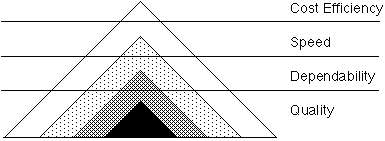Trade-off Models

The conventional trade-off model states that unless there
is some slack in the system, improving any one of the four basic
manufacturing capabilities - Quality, Dependability, Speed and
Cost - must necessarily be at the expense of one or more of the
other three. In the short term this seems to be the case. The
picture often used is of a balance or a see-saw (above).
Professor Nigel Slack (of Warwick Business School) has pointed
out that there is an alternative to disturbing the balance and
that is to raise the fulcrum or balance point, thus (in the example
above) simultaneously reducing cost and increasing speed. In
this example the fulcrum would be either Quality or Dependability.
This ties in well with Ferdows and De Meyer's "Sand Cone"
model described below.
The Sand Cone Model
The Sand Cone model suggests that although in the short term
it is possible to trade off capabilities one against the other,
there is actually a hierarchy amongst the four capabilities.
To build cumulative and lasting manufacturing capability,
management attention and resources should go first towards enhancing
quality, then - while the efforts to enhance quality are further
expanded - attention should be paid to improve also the dependability
of the production system, then - and again while efforts on the
previous two are further enhanced - production flexibility (or
reaction speed) should also be improved, and finally, while all
these efforts are further enlarged, direct attention can be paid
to cost efficiency.
Most of the traditional management approaches for improving
manufacturing performance are built on the trade-off theory.
Ferdows and de Meyer suggest the trade-off theory does not apply
in all cases. Rather, certain approaches change the trade-off
relationship into a cumulative one - i.e., one capability is
built upon another, not in its place.
Applying this model requires a long term approach, tolerance
and patience. It requires believing that costs will eventually
come down.

The conventional illustration is shown above, however a representation
that more accurately reflects the model, which implies that each
lower layer must be extended in order to support any increase
in any higher layer, is shown below.

Reference
- Ferdows, K. & De Meyer, A., Lasting Improvements in Manufacturing
Performance: In Search of a New Theory. Journal of Operations
Management, 1990, Vol. 9, No. 2, pp 168-184.
|